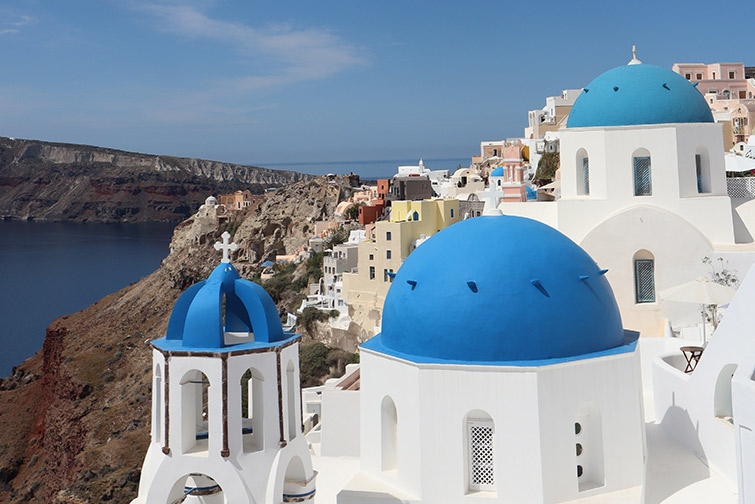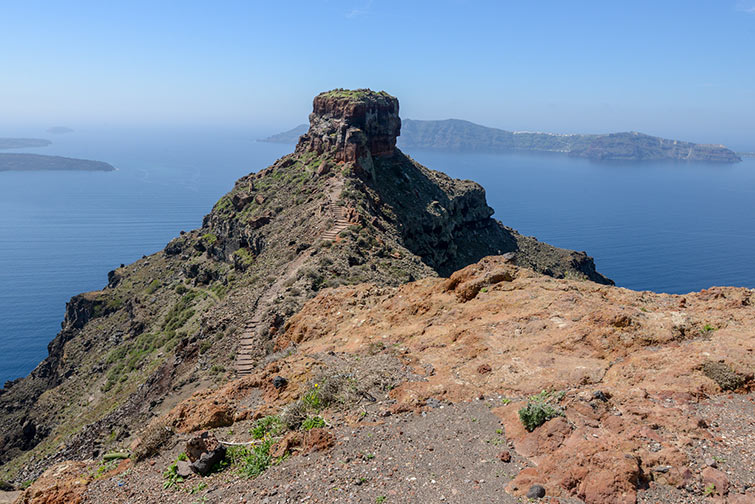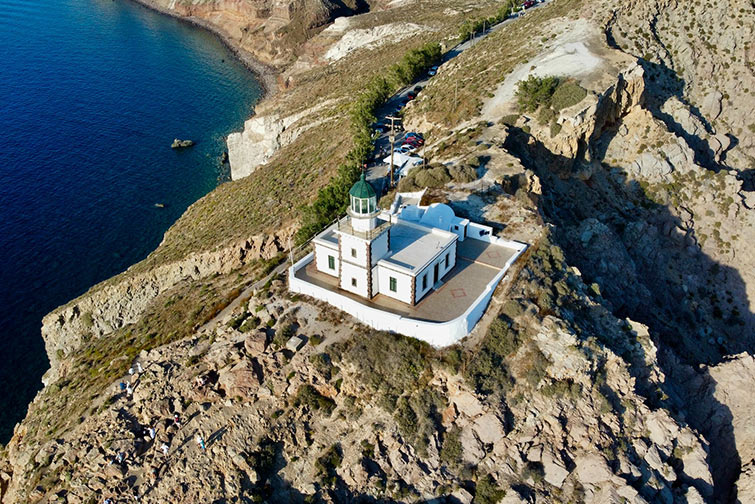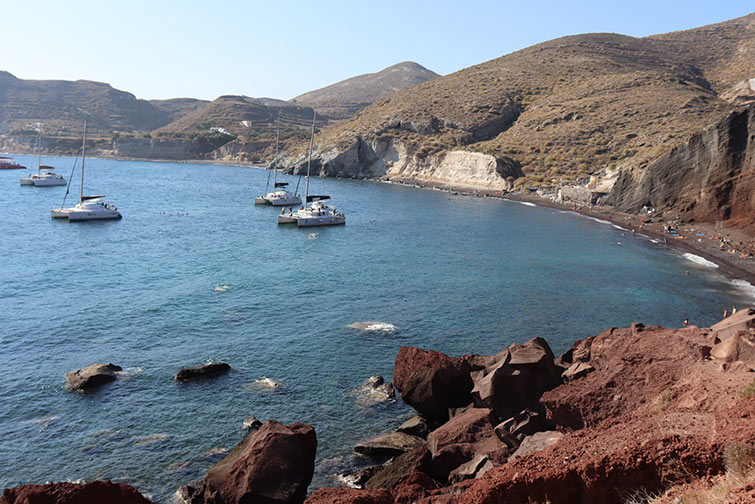Santorini is an attractive destination in Greece visited by many people every year. It is some sort of a jewel of the Aegean with iconic white-washed architecture with blue-domed roofs, dramatic views, and cool sunsets. In this article, you will learn about the best and the most enchanting photography spots in Santorini villages. As well as additional information on where to stay and how to travel around the island.
A Little Bit of the Island History
Santorini is a volcanic island that was formed in 1613 BC by a massive volcanic eruption. Formerly it was the home to the Minoan civilization concentrating around the city of Akrotiri, now an archeological site. The Thera eruption buried the city under ash. Thanks to the soil it has a long history of winemaking. During medieval times Venetians inhabited the land and were responsible for constructing castles and fortresses. Later in the 16th century Ottomans got control over the island for some period too.
Photography Spots
Oia Sunset
The history of this northern village dates back to the medieval times. Back then it was Apano Meria and it was a maritime center during Venetians. Over the centuries this place evolved into nowadays iconic white-washed buildings with blue tops. You may see many photographs from this place with the sunset`s golden hues accompanied by the picturesque cliffside backdrop.

Blue Dome Churches in Fira
Fira is the capital city of the island. Its rich history goes back to the 9th century BC. The name of this place has changed many times, for example, Thera is one of its past names. Likewise, the people who ruled it changed too. Among them were Venetians, and Ottomans.
The Greek Orthodox Church has left its landmark in the place in the form of the iconic blue-domed churches. Some of the most notable ones include Anastasi and St. John church.
Besides churches, you can immerse yourself in the local art scene, try food in the restaurants, or go shopping.

Skaros Rock, Imerovigli
The place is sometimes called the balcony of the Aegean due to the great views of the caldera and the deep blue sea. From a historical point of view, it was an important fortified settlement during Venetian rule. The Skaros Rock was a prominent formation with a medieval castle. The castle functioned as protection against pirates. Nowadays you can find some of its ruins as a testament to the forgotten era. The village is more relaxed and quiet than the previous two.

Akrotiri Lighthouse & Red Beach
You can find the lighthouse in the southern part of the island. Back in time, it was a maritime spot for ships that traveled across the Aegean Sea. It was built in 1892 by a French company. Akrotiri is the nearest village that is also known for being connected to the ancient Minoan city. The place is less touristy and crowded, some would say untouched by it.

If you want to capture the place with your photography gear, the best time are early morning, or late afternoon until sunset. You can create panoramic views of the caldera, the deep blue waters as well as the nearby islands. The lighthouse will make a striking silhouette against the sky, a dramatic focal point, especially during the golden hour.
Another interesting place for taking pictures is the Red Beach near Akrotiri. It is some sort of natural wonder, volcanic rocks in bright scarlet, maroon to crimson-red colors. This unique red is attributed to the iron-rich volcanic rocks and sedimentary deposits. The beach can get crowded so it is advised to come early morning or late afternoon in case you want the capture nature without people in it.

Pyrgos Castle
Pyrgos is located in the center of the island. You can find here the Pyrgos Castle, also known as the Kasteli. It was built in the Middle Ages when the Venetians ruled this place. With its strategic position, it served as a fortress as well as an administrative center. Whether you are into history or photography you will find here something interesting and worth exploring. Stone walls in combination with white-washed buildings, and cobblestone streets in juxtaposition to contemporary Santorini.
Kamari & Perissa Beaches
Kamari Beach is situated in the southeast of Santorini. It used to be part of the Ancient Thera settlement founded in the 9th century BC by the Dorians. You can find the ruins of the hill with a view overlooking Kamari. You can expect a black sand beach with a seafront promenade with cafes, restaurants, and bars. Watersports are very popular too and give you a chance to capture some energetic moments of beachgoers and sports lovers.
Perissa Beach is also located on the southeast coast and connected to the ancient city of Thera. Similarly to Kamari Beach, this one comes with black sand and a long promenade with many beachfront bars, shops, and restaurants.

Megalochori`s Cobbled Streets
The village of Megalochori is one of the most historic and well-preserved villages. It was founded during Venetian rule in the 17th century and its influence can be seen in well-planned streets and traditional Cycladic-style houses. Accompanied with vineyards and traditional wineries you can see it as a living museum of the island`s architectural and cultural heritage.

Emporio Kasteli
This is the largest village on the island and is home to Kasteli fortress from the 15th century. It has a pleasant and peaceful atmosphere, labyrinth layout, stone walls, towers, narrow alleys, and traditional Cycladic architecture. The place is great for any type of lifestyle, portrait, and architecture photography.
Vineyards in Messaria
In the heart of Santorini lies Messaria. Its history is intertwined with viticulture and dates back many centuries. Unique grape varieties such as Athiri, Aidani, or Assyrtiko make it an ideal place for winemaking. You can find many family-owned wineries. Some of them offer not only wine tasting but also tours that let you immerse deeply into Santorini`s winemaking heritage.

Old Windmills in Exo Gonia
Exo Gonia is a small village with some old windmills that were crucial way back in time in 19th century. They were used for grinding wheat and other grains. The village is relatively less crowded and less touristy, laidback with a slow-paced life and atmosphere.

Traditional Finikia
The name Finikia comes from the Greek word “palm tree” – a symbol of the village`s past times when it was agricultural hub. Palm tree cultivation was one of its main activities. Besides typical Cycladic architecture and windmills, you expect to see cave houses. Some of them have been turned into living and modern accommodations over the years.
Where to Stay
Budget-Friendly
Stelios Place (Perissa): A family-run budget hotel in Perissa, known for its friendly atmosphere and proximity to the beach.
Lignos (Fira): A cozy, budget-friendly hotel in Fira with comfortable rooms and a lovely pool area.
Mid-Range
Santorini Palace (Fira): Comfortable rooms, a pool with a view, and it’s located in the heart of Fira.
Apanemo (Akrotiri): A charming, mid-range property in Akrotiri with stunning views, comfortable rooms, and a relaxing atmosphere.
Upscale
Volcano View Hotel (Fira): Luxurious amenities and breathtaking views of the caldera. It’s a short walk from Fira’s center.
Santo Maris Oia Luxury Suites & Spa (Oia): Offers private plunge pools, a spa, and incredible sunset views.
Luxurious
Canaves Oia Suites (Oia): Elegant suites, private pools, and an excellent restaurant, offering a true taste of Santorini luxury.
Katikies Hotel (Oia): A renowned luxury hotel in Oia with breathtaking caldera views, infinity pools, and top-notch service.
Ultra-Luxurious
Grace Santorini (Imerovigli): This ultra-luxurious hotel in Imerovigli is famous for its infinity pool, fine dining, and exceptional service.
Mystique, a Luxury Collection Hotel (Oia): One of the most luxurious hotels on the island, Mystique offers stunning suites, an infinity pool, and world-class amenities with direct access to the sea.
Sources:
wikipedia.com
tripadvisor.com
lonelyplanet.com
Google Maps and reviews

About Author
Freya
Photographer, artist, content creator, and a solo female traveler since 2017.
